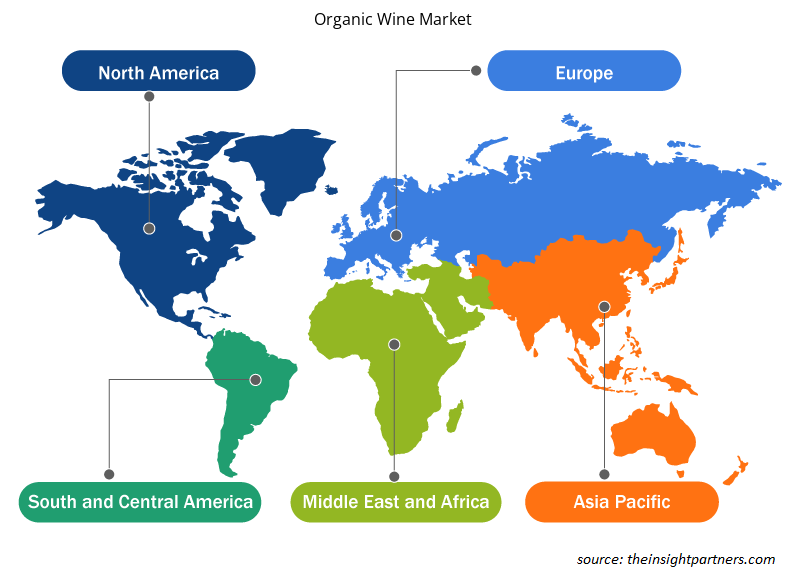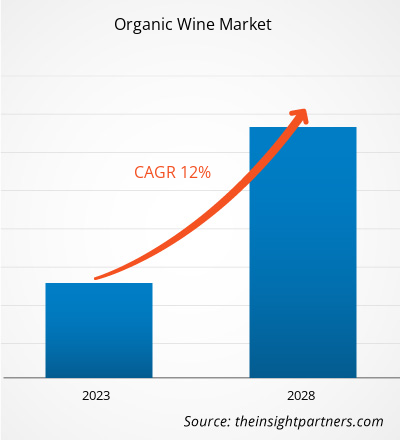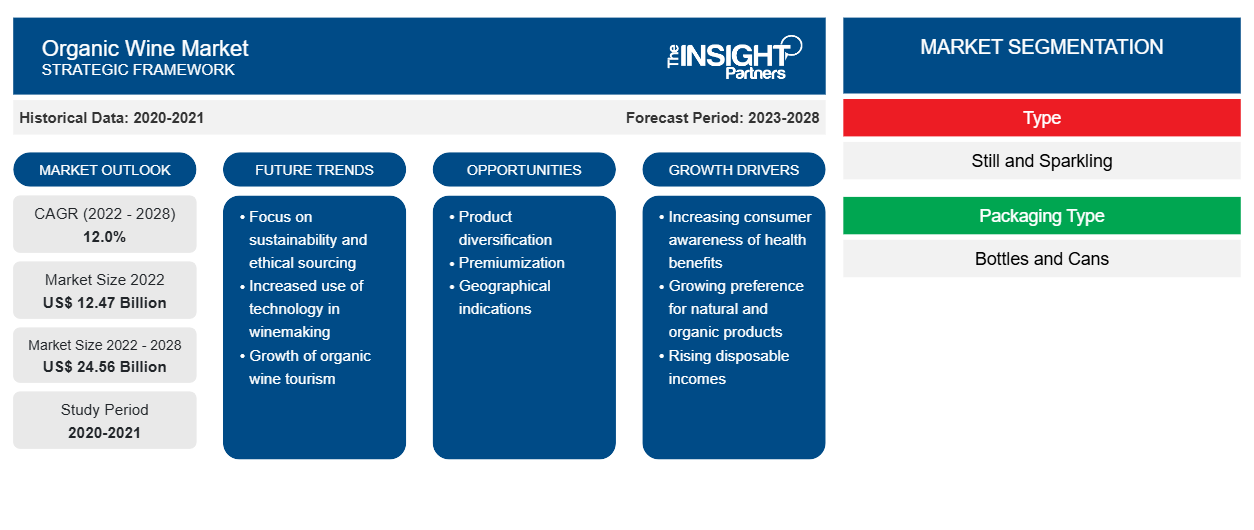Der Markt für Biowein soll von 12.471,20 Millionen US-Dollar im Jahr 2022 auf 24.557,14 Millionen US-Dollar im Jahr 2028 anwachsen. Für den Zeitraum 2022–2028 wird mit einer durchschnittlichen jährlichen Wachstumsrate von 12,0 % gerechnet.
Das Wachstum des Marktes ist auf die schnell wachsende Vorliebe der Verbraucher für biologische und nachhaltige Lebensmittel und Getränke zurückzuführen. Heutzutage haben die Menschen einen weiterentwickelten Lebensstil und gesellschaftliche Werte, was die Nachfrage nach Biogetränken wie Biowein ankurbelt. Die digitale Technologie, die ihnen den Zugang zu verschiedenen Produkten ermöglicht, hat die Nachfrage nach Biowein weiter gefördert. Biowein ist in vielen Geschmacksrichtungen und Verpackungen erhältlich; Rotwein, Weißwein und Roséwein werden beispielsweise in Flaschen und Dosen unterschiedlicher Größe abgefüllt, was die Auswahl für die Verbraucher erhöht hat. Darüber hinaus hat die zunehmende Zahl von Initiativen der Regierungen zur Förderung nachhaltiger Landwirtschaft zu einer erhöhten Produktion von Biowein geführt. Die höhere Verfügbarkeit von Biowein und das Bewusstsein für die Produktvorteile tragen erheblich zur Nachfrage nach Biowein bei.
Im Jahr 2021 hielt Europa den größten Anteil am globalen Bioweinmarkt . Es wird jedoch geschätzt, dass Nordamerika im Prognosezeitraum die höchste durchschnittliche jährliche Wachstumsrate des Marktes verzeichnen wird. Der Bioweinmarkt in Nordamerika ist in die USA, Kanada und Mexiko unterteilt. Die USA gehören volumenmäßig zu den größten Weinkonsumenten. Von den Vereinten Nationen veröffentlichte Daten zeigen zudem, dass es im Land eine wachsende Zahl ökologischer Weinbaubetriebe gibt und große Mengen Wein aus Europa importiert.
Passen Sie diesen Bericht Ihren Anforderungen an
Sie erhalten kostenlos individuelle Anpassungen an jedem Bericht, einschließlich Teilen dieses Berichts oder einer Analyse auf Länderebene, eines Excel-Datenpakets sowie tolle Angebote und Rabatte für Start-ups und Universitäten.
-
Holen Sie sich die wichtigsten Markttrends aus diesem Bericht.Dieses KOSTENLOSE Beispiel umfasst eine Datenanalyse von Markttrends bis hin zu Schätzungen und Prognosen.
Auswirkungen der COVID-19-Pandemie auf den Markt für Bioweine
Die COVID-19-Pandemie hat die Betriebseffizienz des Fertigungssektors aufgrund längerer Lockdowns, Stilllegungen von Produktionseinheiten, Reisebeschränkungen, internationalen Handelsverboten, Lieferkettenunterbrechungen und Rohstoffengpässen erheblich beeinträchtigt. Dies hat letztendlich den Markt für Biowein behindert. Die Unterbrechung der Lebensmittel- und Getränkeindustrie aufgrund der durch den Ausbruch verursachten Konjunkturabschwächung behinderte das Marktwachstum ebenfalls. Die Unternehmen haben sich jedoch erholt, da zuvor verhängte Beschränkungen in verschiedenen Ländern gelockert werden. Die vorübergehende Unterbrechung, auf die die Erholung folgte, hat zu einem starken Wachstum des Bioweinmarktes geführt.
Die Einführung von COVID-19-Impfstoffen durch die Regierungen mehrerer Länder hat die Situation weiter entspannt und zu einem Anstieg der Geschäftsaktivitäten weltweit geführt. Darüber hinaus planen die Regierungen mehrerer Länder den Aufbau einer modernen und technologisch fortschrittlichen Infrastruktur, um die wirtschaftlichen Auswirkungen der COVID-19-Pandemie abzumildern. Während des Lockdowns kauften die Verbraucher Wein selbst, anstatt ihn in Hotels, Restaurants und Bars zu kaufen, was zu einem starken Wachstum der Bioweinverkäufe führte. Daher wird erwartet, dass der Markt für Biowein trotz der negativen Auswirkungen der COVID-19-Pandemie in den kommenden Jahren deutlich wachsen wird.
Markteinblicke
Wachsende Vorliebe für Bio-Produkte
Biowein erfreut sich immer größerer Beliebtheit, da er aus Trauben hergestellt wird, die den ökologischen Landbaumethoden entsprechen. Künstliche und chemische Düngemittel, Fungizide, Insektizide und Herbizide sind von staatlichen Stellen für die Produktion nicht zugelassen. Biowein ist gesünder, da er viele Antioxidantien, Vitamine und Mineralien enthält. Resveratrol, das in Rotwein enthalten ist, hilft, den Cholesterinspiegel zu senken und Krebs vorzubeugen. Mehrere Organisationen wie USDA Organic, Demeter und Eco Cert regulieren und unterstützen die Produktion von Biowein.
Typbasierte Erkenntnisse
Der globale Markt für Bioweine ist nach Sorten unterteilt in stille und Schaumweine. Im Jahr 2021 hatte das stille Segment einen größeren Marktanteil. Es wird jedoch erwartet, dass das Schaumweinsegment im Prognosezeitraum mit einer höheren durchschnittlichen jährlichen Wachstumsrate wächst. Die meisten stillen Weine werden zum sofortigen Trinken entwickelt, während einige für eine Flaschenreifung unter optimalen Kellerbedingungen hergestellt werden. Diese stillen Bioweine werden aus fermentiertem Traubensaft hergestellt. Darüber hinaus wird erwartet, dass stiller Biowein aufgrund der Verfügbarkeit verschiedener Variationen mit eingebrachten Gewürzen und Fruchtaromen eine hohe Nachfrage verzeichnen wird. Daher wird erwartet, dass das Segment der stillen Bioweine im Prognosezeitraum wachsen wird.
Avondale, Elgin Ridge Wines, Kendall-Jackson, The Organic Wine Company, Bronco Wine Company, King Estate Winery, Grgich Hills Estate, Emiliana Organic Vineyards, Società Agricola Querciabella Spa und Frey Vineyards sind die Akteure auf dem Bioweinmarkt. Diese Unternehmen bieten dem Markt ein breites Produktportfolio. Die Unternehmen sind in den Entwicklungsregionen präsent, was dem Markt lukrative Möglichkeiten bietet. Die Marktteilnehmer entwickeln qualitativ hochwertige, innovative Produkte, um die Kundenanforderungen zu erfüllen.
Regionale Einblicke in den Bioweinmarkt
Die regionalen Trends und Faktoren, die den Bioweinmarkt im Prognosezeitraum beeinflussen, wurden von den Analysten von Insight Partners ausführlich erläutert. In diesem Abschnitt werden auch die Marktsegmente und die Geografie des Bioweinmarkts in Nordamerika, Europa, im asiatisch-pazifischen Raum, im Nahen Osten und Afrika sowie in Süd- und Mittelamerika erörtert.

- Erhalten Sie regionalspezifische Daten zum Bioweinmarkt
Umfang des Biowein-Marktberichts
| Berichtsattribut | Details |
|---|---|
| Marktgröße im Jahr 2022 | 12,47 Milliarden US-Dollar |
| Marktgröße bis 2028 | 24,56 Milliarden US-Dollar |
| Globale CAGR (2022 - 2028) | 12,0 % |
| Historische Daten | 2020-2021 |
| Prognosezeitraum | 2023–2028 |
| Abgedeckte Segmente |
Nach Typ
|
| Abgedeckte Regionen und Länder |
Nordamerika
|
| Marktführer und wichtige Unternehmensprofile |
|
Dichte der Akteure auf dem Bioweinmarkt: Die Auswirkungen auf die Geschäftsdynamik verstehen
Der Markt für Biowein wächst rasant, angetrieben durch die steigende Nachfrage der Endverbraucher aufgrund von Faktoren wie sich entwickelnden Verbraucherpräferenzen, technologischen Fortschritten und einem größeren Bewusstsein für die Vorteile des Produkts. Mit der steigenden Nachfrage erweitern Unternehmen ihr Angebot, entwickeln Innovationen, um die Bedürfnisse der Verbraucher zu erfüllen, und nutzen neue Trends, was das Marktwachstum weiter ankurbelt.
Die Marktteilnehmerdichte bezieht sich auf die Verteilung der Firmen oder Unternehmen, die in einem bestimmten Markt oder einer bestimmten Branche tätig sind. Sie gibt an, wie viele Wettbewerber (Marktteilnehmer) in einem bestimmten Marktraum im Verhältnis zu seiner Größe oder seinem gesamten Marktwert präsent sind.
Die wichtigsten auf dem Markt für Biowein tätigen Unternehmen sind:
- Die Kellogg Company
- Avondale
- Weine aus Elgin Ridge
- Kendall Jackson
- Die Organic Wine Company
Haftungsausschluss : Die oben aufgeführten Unternehmen sind nicht in einer bestimmten Reihenfolge aufgeführt.

- Überblick über die wichtigsten Akteure auf dem Bioweinmarkt
Bericht-Spotlights
- Fortschrittliche Branchentrends im Markt für Bioweine helfen den Akteuren bei der Entwicklung wirksamer langfristiger Strategien
- In Industrie- und Entwicklungsländern angewandte Strategien für Unternehmenswachstum
- Quantitative Analyse des Bioweinmarktes von 2020 bis 2028
- Schätzung der weltweiten Nachfrage nach Bioweinen
- Porters Fünf-Kräfte-Analyse zur Veranschaulichung der Wirksamkeit von Käufern und Lieferanten in der Branche
- Aktuelle Entwicklungen zum Verständnis des Wettbewerbsmarktszenarios
- Markttrends und -aussichten sowie Faktoren, die das Wachstum des Bioweinmarktes vorantreiben und bremsen
- Unterstützung im Entscheidungsprozess durch Aufzeigen von Marktstrategien, die das kommerzielle Interesse untermauern und zum Marktwachstum führen
- Die Größe des Bioweinmarktes an verschiedenen Knotenpunkten
- Detaillierte Übersicht und Segmentierung des Marktes sowie der Dynamik der Bioweinindustrie
- Größe des Bioweinmarktes in verschiedenen Regionen mit vielversprechenden Wachstumschancen
Die „Globale Marktanalyse für Biowein bis 2028“ ist eine spezialisierte und eingehende Studie der Lebensmittel- und Getränkeindustrie mit besonderem Schwerpunkt auf der globalen Trendanalyse des Bioweinmarkts. Der Bericht soll einen Überblick über den Markt mit detaillierter Marktsegmentierung bieten.
Der Markt für Biowein ist nach Typ, Verpackungsart, Vertriebskanal und Geografie segmentiert. Basierend auf dem Typ ist der Markt in stillen und prickelnden Wein unterteilt. Basierend auf der Verpackungsart ist der Markt in Flaschen und Dosen unterteilt. Basierend auf dem Vertriebskanal ist der Markt in Supermärkte und Hypermärkte, Fachgeschäfte, Online-Einzelhandel und Direktverkauf segmentiert. Nach Geografie ist der Markt grob in Nordamerika, Europa, Asien-Pazifik (APAC), Naher Osten und Afrika (MEA) sowie Süd- und Mittelamerika segmentiert.
Firmenprofile
- Avondale
- Weine aus Elgin Ridge
- Kendall Jackson
- Die Organic Wine Company
- Bronco Weinunternehmen
- Weingut King Estate
- Grgich Hills Anwesen
- Bio-Weinberge Emiliana
- Società Agricola Querciabella Spa
- Frey Weinberge
- Historische Analyse (2 Jahre), Basisjahr, Prognose (7 Jahre) mit CAGR
- PEST- und SWOT-Analyse
- Marktgröße Wert/Volumen – Global, Regional, Land
- Branchen- und Wettbewerbslandschaft
- Excel-Datensatz
Aktuelle Berichte
Verwandte Berichte
Erfahrungsberichte
Grund zum Kauf
- Fundierte Entscheidungsfindung
- Marktdynamik verstehen
- Wettbewerbsanalyse
- Kundeneinblicke
- Marktprognosen
- Risikominimierung
- Strategische Planung
- Investitionsbegründung
- Identifizierung neuer Märkte
- Verbesserung von Marketingstrategien
- Steigerung der Betriebseffizienz
- Anpassung an regulatorische Trends























 Kostenlose Probe anfordern für - Bio-Weinmarkt
Kostenlose Probe anfordern für - Bio-Weinmarkt